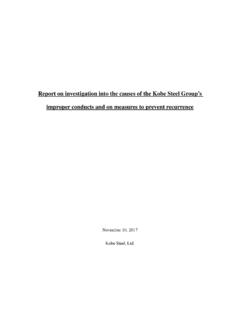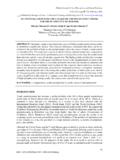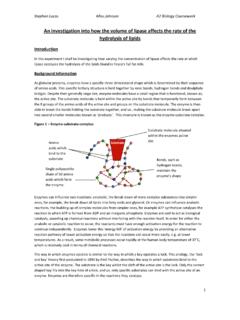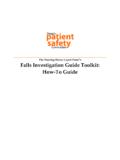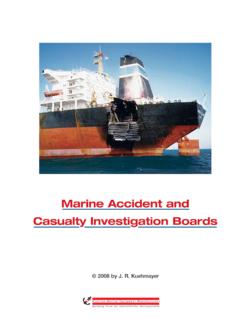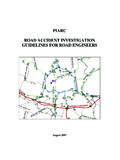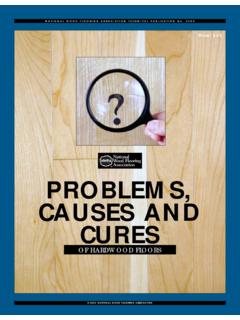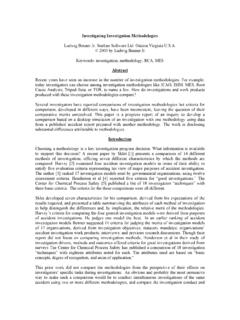Transcription of OPERTIONAL GUIDANCE INVESTIGATION PROCEDURE
1 OPERTIONAL GUIDANCE INVESTIGATION PROCEDURE VERSION June 2017 OVERVIEW This PROCEDURE describes how we carry out investigations into work-related incidents that have resulted in death, physical injury, occupational disease or dangerous occurrences. The purpose of an INVESTIGATION is to find out what happened in an incident, and why, and to take enforcement action, where appropriate, that accords with the principles of HSE s Enforcement Policy Statement. Operational directors expect that investigations will be actively managed so that they are conducted and completed within the shortest practicable timescales, taking into account scale and complexity and the need to achieve the right outcomes.
2 Our policy is to continue an INVESTIGATION solely to the extent of meeting our regulatory functions and the legal requirements for criminal investigations. Therefore, managers and inspectors will justifiably decide to stop an INVESTIGATION at the point where those objectives have been achieved. The emphasis is on prompt and positive decision-making during initial planning and subsequent reviews as the key to making timely progress and avoiding delay. The PROCEDURE provides the framework, generic objectives and performance standards for incident investigations.
3 The material is arranged in a logical flow, but some flexibility is necessary in practice because the pathway through an INVESTIGATION can vary according to circumstances. COMAH Competent Authority (CA) Inspectors should also refer to the COMAH Remodelling INVESTIGATION PROCEDURE that provides a common framework for CA investigations at COMAH establishments and supplements this PROCEDURE . This can be found on the COMAH competent authority web community Some activities that are related to INVESTIGATION are not covered under this PROCEDURE . Please refer to the relevant instructions and GUIDANCE on the following: Receipt and handling of incoming reports, mainly under RIDDOR Cost recovery INVESTIGATION reports and work recording, including IMPACT and MEMT.
4 The PROCEDURE is in three sections, summarised below: All incidents Applies to fatal incidents, following on from the initial and specific action for work-related deaths Decision to investigate Initial planning Conduct and management including reviews Conclusion Fatal incidents Initial response Management of joint INVESTIGATION Potential major incidents Major incident or civil contingency event Relevant to other serious/high profile events. The content of each section is arranged under: OPERTIONAL GUIDANCE INVESTIGATION PROCEDURE VERSION June 2017 Headlines Summary of the section s scope and content Responsibilities and actions The headlines expanded into who and what (with flexibility between roles to maintain pace) Performance standards and criteria Our policies in terms of quality, criteria, timescales and factors to take into account OPERTIONAL GUIDANCE INVESTIGATION PROCEDURE VERSION June 2017 ALL INCIDENTS This section covers.
5 Decisions whether to investigate reported incidents (except where already actioned for fatal and major incidents) initial planning conducting and managing, including reviews concluding investigations, including when to curtail. DECISION WHETHER TO INVESTIGATE HEADLINES Apply the Incident Selection Criteria (ISC) to decision-making Identify incidents mandatory for INVESTIGATION Arrange for initial enquiries to be made where necessary Re-direct incidents that are not within HSE s enforcement responsibility Justify decisions not to investigate incidents that meet the ISC with reasons Re-allocate investigations where local workload pressures would lead to delay RESPONSIBILITIES & ACTIONS Band 2 Select incidents that meet the ISC as mandatory for INVESTIGATION where there is enough available information to decide without further enquiry
6 Re-direct any incidents that are not for HSE in accordance with the relevant Memorandum of Understanding, Protocol or other GUIDANCE Arrange for initial enquiries* into incidents that fit the Criteria: Initial enquiries in order to reach a decision whether INVESTIGATION is mandatory (* by administrative support team, VO/RCO or inspector as appropriate) Decide whether any incidents meeting the ISC should not be investigated Record a decision not to investigate directly on COIN (DRFs are no longer Required), selecting one of the reasons given in the Criteria: Factors weighing against INVESTIGATION Inform the Band 1 if the team does not have the capacity to take on an incident that should be investigated.
7 Band 1 Re-allocate investigations across teams, Units and Divisions when resourcing issues arise. OPERTIONAL GUIDANCE INVESTIGATION PROCEDURE VERSION June 2017 CRITERIA FOR DECISION-MAKING Initial enquiries Enquiries should be made when there is not enough information to decide whether: one of the factors weighing against a decision to pursue an INVESTIGATION might apply, even though the incident meets the ISC a serious incident to a non-employee falls within HSE s priorities for enforcement on Section 3. Enquiries should not continue beyond the point when the Band 2 has enough information to decide whether to investigate or not.
8 Factors weighing against INVESTIGATION The grounds for not investigating incidents that meet the selection criteria are where: it is impractical to do so, for example where key witnesses or other evidence is unavailable workers returned overseas. it is clear that all reasonably practicable precautions were in place at the time of the incident to reduce the risk of it occurring PERFORMANCE STANDARD Timescales for selection decisions The decision whether to investigate should be made within 5 working days from when the Band 2 receives notification, or as soon as the information essential to making a decision becomes available.
9 INITIAL PLANNING HEADLINES Assess the incident and resource the INVESTIGATION Gather relevant information about the dutyholder(s) where their identity is known Set initial objectives and identify any fast-track actions Consider any necessary support required from specialists or the Sector at the outset Involve and communicate with other enforcement agencies where appropriate Identify any foreseeable health and safety issues and site conditions that may affect the investigators following the GUIDANCE set out in Supporting staff who may be or have been exposed to traumatic events.
10 OPERTIONAL GUIDANCE INVESTIGATION PROCEDURE VERSION June 2017 Produce a fit-for-purpose plan RESPONSIBILITIES & ACTIONS Band 2 Take account of the following factors when allocating resources to the INVESTIGATION : o its likely scale and complexity o the type and volume of material to be collected while fresh and available o the urgency for first attendance at the site o the most appropriate mix of inspector and VO/RCO deployment Ensure that the lead inspector s initial objectives and actions are appropriate and geared to making timely and effective progress Set the timing of the first review.










